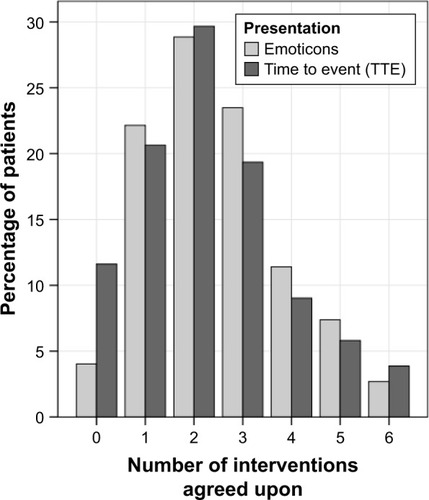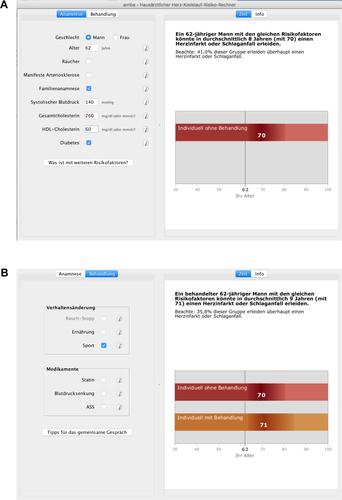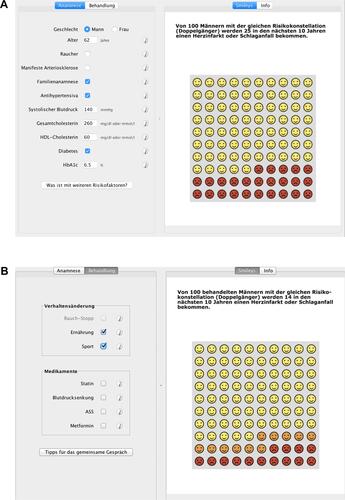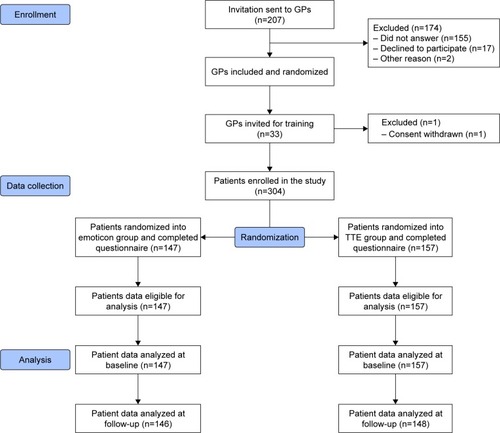Figures & data
Table 1 Characteristics of the study population (n=294)
Figure 2 Frequency distribution of number of interventions discussed and agreed upon per patient per study arm.

Table 2 Mean adherence in relation to number of interventions discussed
Table 3 Risk perception and self-rated importance of avoiding a cardiovascular event over time, depending on risk representation
Figure S1 TTE interface of Arriba decision aid.
Notes: (A) Medical history-taking. On the left, parameters of medical history must be filled in (top to bottom): sex, age, smoking status, presence of manifest arteriosclerosis, positive family history, taking of antihypertensive medications, systolic blood pressure, total cholesterol level, high-density-lipoprotein level, and presence of diabetes. On the right, the time-to-event (TTE) graph is displayed, accompanied by the information that “A 62-year-old man with the same risk profile could suffer a myocardial infarction or stroke on average 8 years from now (at 70 years of age)”. (B) Visualization of treatment options. On the left, the treatment options are shown (from top to bottom): behavioral changes, ie, smoking cessation, nutrition, and sports, and drug treatment, ie, statins, antihypertensive drugs, and aspirin. On the right, TTE graphs are displayed, accompanied by the information that “A 62-year-old treated man with the same risk profile could suffer a myocardial infarction or stroke on average 9 years from now (at 71 years of age)”. Risk reduction (here due to sports) is indicated with the orange timeline. Statistical information added: “35.8% of this group suffer a myocardial infarction or stroke”.

Figure S2 Emoticon interface of Arriba decision aid.
Notes: (A) Medical history-taking. On the left, parameters of medical history must be filled in (from top to bottom): sex, age, smoking status, presence of manifest arteriosclerosis, positive family history, taking of antihypertensive medications, systolic blood pressure, total cholesterol level, high-density-lipoprotein level, presence of diabetes, and HbA1c level. On the right, the emoticons are displayed, accompanied by the information that: “Of 100 men with the same risk profile, 25 will suffer a myocardial infarction or stroke within the next 10 years”. (B) Visualization of treatment options. On the left, treatment options are shown (from top to bottom): behavioral changes, ie, smoking cessation, nutrition, and sports, and drug treatment, ie, statins, antihypertensive drugs, aspirin, and metformin. On the right, the emoticons are displayed, accompanied by the information that: “Of 100 treated men with the same risk profile, 14 will suffer a myocardial infarction or stroke within the next 10 years”. Risk reduction (here due to nutrition modification and sports) is indicated with orange emoticons.

Availability of data and materials
All study data and materials are available upon request. This includes the study version of Arriba and specifications regarding the Markov model.


